Mediterranean Rice Recipe takes center stage, inviting you to explore a culinary world brimming with fresh, flavorful ingredients. This cuisine, celebrated for its health benefits, offers a delightful array of rice dishes that are both satisfying and nutritious. From classic Greek recipes to vibrant Spanish variations, Mediterranean rice recipes showcase a symphony of flavors, textures, and aromas, making each bite a culinary adventure.
The heart of Mediterranean rice recipes lies in the use of fresh, seasonal ingredients. Fragrant herbs like oregano, thyme, and rosemary infuse the rice with earthy notes, while vibrant citrus fruits like lemons and oranges add a bright, tangy zest.
Aromatic spices like saffron, cumin, and cinnamon lend warmth and complexity, creating a harmonious blend of flavors that tantalize the palate.
Mediterranean Rice Recipes
Mediterranean cuisine is renowned for its emphasis on fresh, flavorful ingredients and healthy eating habits. This culinary tradition emphasizes the use of seasonal produce, lean proteins, whole grains, and healthy fats, creating a delicious and nutritious balance. Mediterranean rice recipes, inspired by this approach, offer a delightful way to incorporate these principles into your diet.Mediterranean rice recipes are not only delicious but also offer a wealth of health benefits.
The use of whole grains like brown rice provides essential fiber, which aids digestion and promotes a feeling of fullness. The inclusion of fresh vegetables provides a rich source of vitamins, minerals, and antioxidants, contributing to overall well-being. Moreover, the use of olive oil, a cornerstone of Mediterranean cuisine, is known for its heart-healthy monounsaturated fats.
Health Benefits of Mediterranean Rice Recipes
Mediterranean rice recipes offer a range of health benefits due to the use of fresh, wholesome ingredients.
- Rich in Fiber:Brown rice, a staple in many Mediterranean rice recipes, is a good source of dietary fiber. Fiber aids digestion, promotes regularity, and helps you feel full, which can be beneficial for weight management.
- Nutrient-Dense:The inclusion of fresh vegetables in these recipes provides a rich source of vitamins, minerals, and antioxidants. These nutrients support overall health, boost the immune system, and protect against chronic diseases.
- Heart-Healthy Fats:Olive oil, a key ingredient in Mediterranean cuisine, is rich in monounsaturated fats, which are beneficial for heart health. These fats help lower bad cholesterol levels and reduce the risk of heart disease.
- Anti-Inflammatory Properties:The abundance of antioxidants in Mediterranean rice recipes, derived from vegetables and olive oil, contributes to reducing inflammation in the body. Chronic inflammation is linked to various health issues, including heart disease and cancer.
Key Ingredients
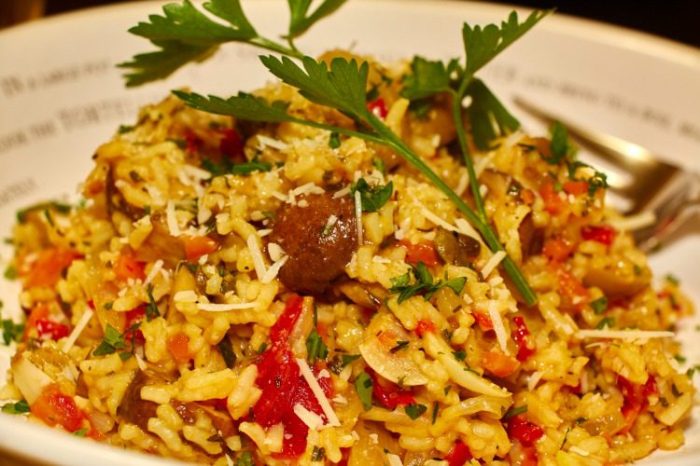
Mediterranean rice dishes are known for their vibrant flavors and aromatic appeal, achieved through a blend of fresh ingredients and spices. Understanding the role of each ingredient is crucial to replicating these delicious recipes.
Common Ingredients, Mediterranean rice recipe
Common ingredients in Mediterranean rice dishes are:
- Rice:The foundation of the dish, rice absorbs the flavors of the other ingredients and provides a neutral canvas for the spices and vegetables. Long-grain rice is commonly used, as it cooks up fluffy and separates well. Basmati rice is another popular choice, known for its delicate aroma and distinct nutty flavor.
- Vegetables:Fresh, seasonal vegetables add color, texture, and nutritional value. Common choices include:
- Onions:Provide a base for the flavor profile, adding sweetness and depth. They are often sautéed with garlic to create a flavorful foundation.
- Garlic:Adds a pungent aroma and flavor that complements the other ingredients.
- Bell Peppers:Contribute a vibrant color and sweetness, and their flavor can range from mild to spicy depending on the variety.
- Tomatoes:Provide acidity and a tangy flavor, balancing the richness of the other ingredients.
- Zucchini:Adds a mild, slightly sweet flavor and a tender texture.
- Mushrooms:Offer an earthy flavor and a meaty texture.
- Spinach:Adds a vibrant green color and a mild, slightly bitter flavor.
- Herbs and Spices:Mediterranean rice dishes are often seasoned with a blend of aromatic herbs and spices, adding complexity and depth to the flavor profile.
- Oregano:A staple in Mediterranean cuisine, oregano adds a warm, earthy flavor.
- Basil:Offers a fresh, slightly sweet flavor that complements the other ingredients.
- Rosemary:Provides a pungent, pine-like flavor.
- Thyme:Adds a slightly lemony, herbaceous flavor.
- Cumin:A warm, earthy spice that adds depth to the flavor profile.
- Paprika:Offers a mild, sweet flavor and a vibrant red color.
- Broth:Used to cook the rice and infuse it with flavor. Chicken broth is a common choice, but vegetable broth can also be used for a vegetarian option.
- Olive Oil:A staple in Mediterranean cuisine, olive oil adds richness and a fruity flavor to the dish. It is also used for sautéing the vegetables.
- Lemon Juice:Adds a bright, tangy flavor that balances the richness of the other ingredients.
- Salt and Pepper:Used to season the dish to taste.
Variations and Substitutions
Mediterranean rice dishes are incredibly versatile and can be adapted to suit different preferences.
Browse the multiple elements of enshrouded hidden crafting recipes blackmire to gain a more broad understanding.
- Rice:While long-grain rice is the most common choice, other types of rice can be used, such as brown rice for a healthier option or Arborio rice for a creamier texture.
- Vegetables:Feel free to use whatever vegetables are in season or readily available. Other popular options include eggplant, artichokes, asparagus, and peas.
- Herbs and Spices:Experiment with different combinations of herbs and spices to create your own unique flavor profile. For a spicier dish, add chili flakes or cayenne pepper.
- Broth:Use any type of broth you prefer, such as beef broth or vegetable broth.
- Olive Oil:Other cooking oils can be used as a substitute for olive oil, such as canola oil or sunflower oil.
Popular Mediterranean Rice Recipes
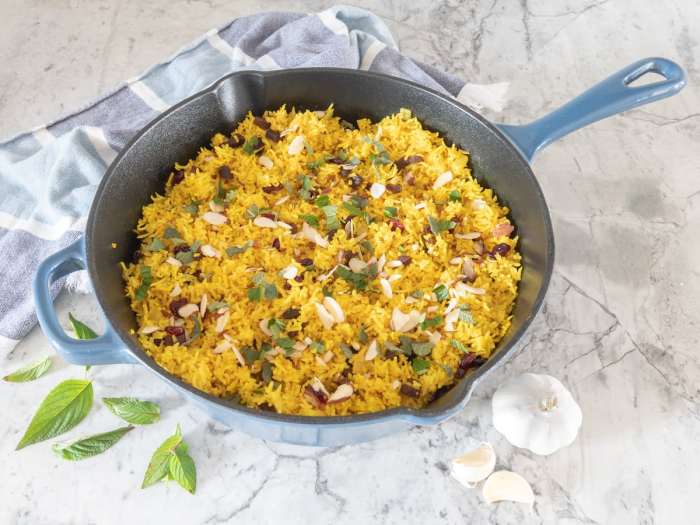
Mediterranean rice dishes are a staple in many cultures across the region, showcasing a delightful blend of flavors, textures, and aromas. These recipes are often passed down through generations, reflecting the rich culinary heritage of the Mediterranean.
Popular Mediterranean Rice Recipes
The following table provides an overview of popular Mediterranean rice recipes, highlighting their key ingredients, preparation steps, and serving suggestions.
| Recipe Name | Key Ingredients | Preparation Steps | Serving Suggestions |
|---|---|---|---|
| Greek Lemon Rice (Avgolemono) | Rice, chicken broth, lemon juice, eggs, dill | 1. Cook rice in chicken broth. 2. Whisk together lemon juice and eggs. 3. Gradually add egg mixture to rice, stirring constantly. 4. Stir in dill. | Serve hot as a side dish or as a main course with grilled chicken or fish. |
| Spanish Paella | Rice, saffron, chicken, seafood, vegetables, olive oil | 1. Sauté chicken and seafood in olive oil. 2. Add rice and saffron. 3. Add vegetables and broth. 4. Simmer until rice is cooked and liquid is absorbed. | Serve hot with aioli or romesco sauce. |
| Moroccan Biryani | Rice, lamb, almonds, raisins, spices (cinnamon, cumin, turmeric) | 1. Marinate lamb with spices. 2. Cook lamb and add rice, almonds, and raisins. 3. Simmer until rice is cooked and liquid is absorbed. | Serve hot with yogurt or raita. |
| Turkish Pilav | Rice, butter, onions, chicken broth, parsley | 1. Sauté onions in butter. 2. Add rice and chicken broth. 3. Simmer until rice is cooked and liquid is absorbed. 4. Stir in parsley. | Serve hot as a side dish or as a main course with grilled kebabs. |
Cooking Techniques
Mediterranean rice dishes often showcase a variety of cooking techniques, each contributing to the unique texture and flavor of the final product. The choice of technique depends on the desired outcome, the ingredients used, and the cook’s personal preference.
Methods of Cooking Rice
Different methods are used for cooking rice in Mediterranean cuisine, each resulting in varying textures and flavors.
- Traditional Stovetop Method:This classic technique involves simmering rice in a pot with water or broth until it absorbs the liquid and becomes tender. It is a simple and versatile method that allows for easy customization with different seasonings and ingredients.
- Pressure Cooker Method:Using a pressure cooker significantly reduces cooking time while achieving perfectly cooked rice. This method is ideal for busy cooks and those who prefer a quicker cooking process.
- Oven Method:Baking rice in the oven provides a gentle and even cooking process, resulting in a fluffy and flavorful dish. This method is often used for rice pilafs and other dishes that require a longer cooking time.
- Rice Cooker Method:A rice cooker takes the guesswork out of cooking rice, automatically adjusting the cooking time and temperature to achieve perfect results. This method is convenient and ideal for those who want a hassle-free cooking experience.
Tips for Achieving Perfect Rice Texture and Flavor
- Rinse the rice:Rinsing rice before cooking removes excess starch, which can make the rice sticky.
- Use the right ratio of liquid to rice:The general rule of thumb is to use a 2:1 ratio of liquid to rice. However, the exact ratio may vary depending on the type of rice and the desired texture.
- Season the cooking liquid:Adding seasonings like salt, herbs, or spices to the cooking liquid infuses the rice with flavor.
- Don’t stir the rice while it’s cooking:Stirring the rice can break it down and prevent it from cooking evenly.
- Let the rice rest:After cooking, let the rice rest for 5-10 minutes before fluffing it with a fork. This allows the rice to absorb any remaining liquid and become fluffy.
Common Cooking Techniques
- Sautéing:Sautéing vegetables or meat before adding rice to the pot adds depth of flavor and creates a more complex dish.
- Simmering:Simmering rice in a pot of liquid ensures that the grains cook evenly and absorb the flavors of the surrounding ingredients.
- Baking:Baking rice in the oven allows for a gentle and even cooking process, resulting in a fluffy and flavorful dish.
Flavor Combinations
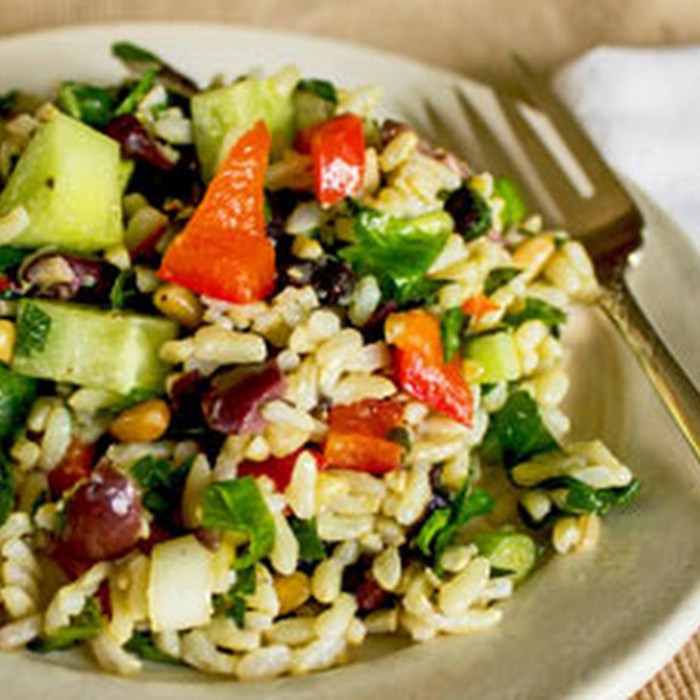
The Mediterranean diet is renowned for its vibrant and aromatic flavors, and these characteristics are beautifully reflected in its rice dishes. The use of herbs, spices, and citrus fruits creates a symphony of tastes that tantalize the palate.
Flavor Profiles and Ingredients
The versatility of Mediterranean rice allows for a wide range of flavor profiles, each with its own unique blend of ingredients. Here are some popular flavor combinations:
| Flavor Profile | Ingredients |
|---|---|
| Citrusy and Herby | Lemon zest, fresh parsley, mint, oregano, garlic, olive oil |
| Spicy and Earthy | Cumin, coriander, paprika, turmeric, cinnamon, cayenne pepper, garlic, onion |
| Savory and Nutty | Pine nuts, almonds, pistachios, dried cranberries, rosemary, thyme, garlic, olive oil |
| Tomato-Based | Crushed tomatoes, tomato paste, basil, oregano, garlic, onion, red pepper flakes |
Serving and Presentation
Mediterranean rice dishes are not only delicious but also visually appealing. Their vibrant colors and textures make them perfect for any occasion, from casual weeknight dinners to special gatherings.
Creative Serving Ideas
There are many ways to serve Mediterranean rice creatively. Here are some suggestions:
- Individual portions:Serve the rice in individual bowls or ramekins for a more elegant presentation. This is especially great for potlucks or parties.
- Layered bowls:Create visually appealing layers of rice, vegetables, and protein in a bowl for a more dynamic and interesting presentation.
- Stuffed vegetables:Fill bell peppers, zucchini, or other vegetables with Mediterranean rice for a hearty and healthy meal. This option is great for a vegetarian or vegan twist.
- Skewers:Thread cooked rice with grilled vegetables and protein on skewers for a fun and portable appetizer or side dish.
Accompaniments and Garnishes
Accompaniments and garnishes can elevate the taste and presentation of Mediterranean rice dishes.
- Fresh herbs:Chopped parsley, mint, cilantro, and dill add freshness and aroma to the dish.
- Citrus wedges:A squeeze of lemon or lime juice adds a bright and tangy flavor to the rice.
- Nuts and seeds:Toasted pine nuts, almonds, or sesame seeds add a nutty crunch and flavor.
- Yogurt or sour cream:A dollop of yogurt or sour cream adds a creamy and tangy contrast to the rice.
- Hummus or baba ghanoush:These dips provide a flavorful and healthy accompaniment to the rice.
- Pickled vegetables:Pickled onions, peppers, or cucumbers add a tangy and crunchy element to the dish.
Elevating the Presentation
- Use colorful bowls or plates:Choose bowls or plates that complement the colors of the rice and other ingredients.
- Garnish with edible flowers:Edible flowers like violas or pansies add a touch of elegance and color.
- Create a visually appealing arrangement:Arrange the rice and other ingredients in a way that is visually appealing and balanced.
- Use different textures:Incorporate different textures, such as crunchy nuts, soft yogurt, and fluffy rice, for a more interesting presentation.
Variations and Adaptations
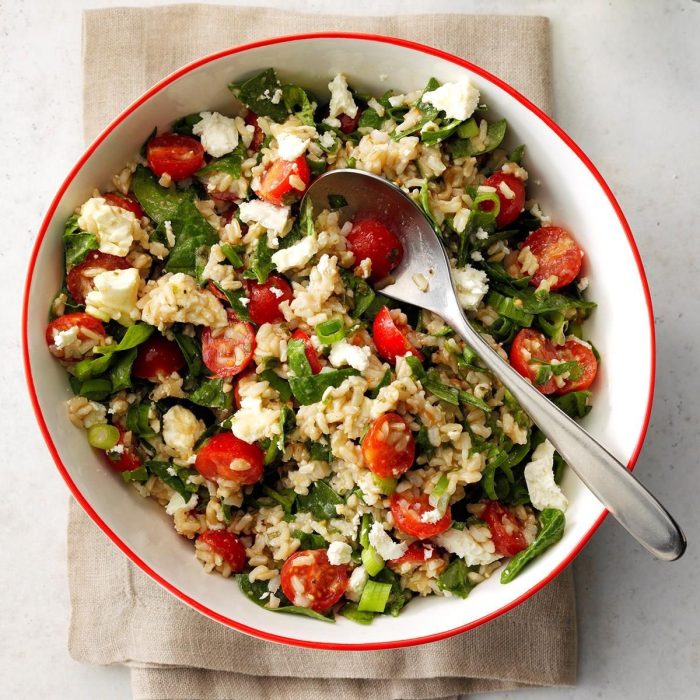
Mediterranean rice dishes are incredibly versatile, offering a wide range of possibilities for customization. These variations often stem from the diverse culinary influences that have shaped Mediterranean cuisine over centuries.
Regional Variations
Regional variations in Mediterranean rice dishes reflect the unique ingredients and culinary traditions of different areas. For instance, Spanish paella, a renowned rice dish, typically features saffron, seafood, and chicken, while Greek rice pilaf often incorporates herbs like dill and mint.
- Spanish Paella:This iconic dish is characterized by its vibrant saffron color and a medley of ingredients that may include seafood, chicken, vegetables, and chorizo.
- Greek Rice Pilaf:Greek rice pilaf is often seasoned with aromatic herbs like dill and mint, and sometimes includes lemon juice for a tangy flavor.
- Moroccan Couscous:While not strictly rice, couscous is a popular grain in Moroccan cuisine, and it’s often prepared with vegetables, dried fruits, and spices like cumin and cinnamon.
Dietary Adaptations
Mediterranean rice recipes can be adapted to accommodate various dietary needs.
- Vegetarian:Many Mediterranean rice dishes are naturally vegetarian, and you can easily enhance them by adding more vegetables, legumes, or nuts.
- Gluten-Free:Rice is naturally gluten-free, making it a suitable option for those following a gluten-free diet. Be sure to choose gluten-free stock and other ingredients as needed.
- Vegan:To make a Mediterranean rice dish vegan, simply omit any animal products, such as cheese or chicken, and replace them with plant-based alternatives.
Health Benefits: Mediterranean Rice Recipe
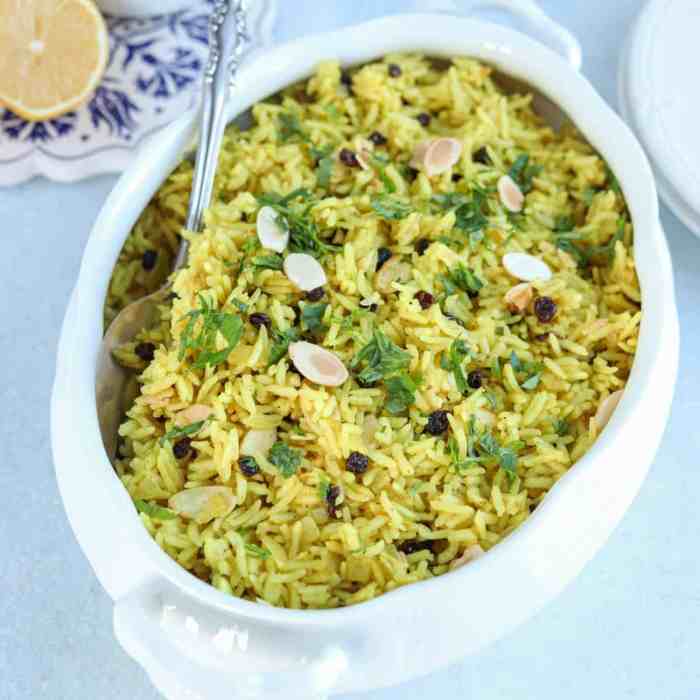
Mediterranean rice dishes are not only delicious but also offer a range of health benefits due to their nutrient-rich ingredients. By incorporating these recipes into a balanced diet, you can enjoy various advantages for your overall well-being.
Nutritional Value of Mediterranean Rice
Mediterranean rice recipes typically feature a combination of whole grains, vegetables, legumes, and lean protein sources, contributing to a balanced and nutritious meal. The nutritional value of these dishes can vary depending on the specific ingredients used, but generally, they are a good source of:
- Fiber:Whole grains, such as brown rice, quinoa, and barley, are excellent sources of dietary fiber, which aids digestion, promotes regularity, and helps control blood sugar levels.
- Complex Carbohydrates:Complex carbohydrates provide sustained energy and are essential for maintaining healthy blood sugar levels.
- Protein:Legumes, such as chickpeas and lentils, are excellent sources of plant-based protein, which is important for muscle building, tissue repair, and hormone production.
- Vitamins and Minerals:Vegetables and legumes are rich in essential vitamins and minerals, including vitamin C, folate, potassium, and magnesium, which play crucial roles in various bodily functions.
- Antioxidants:Many Mediterranean ingredients, such as olive oil, tomatoes, and herbs, are rich in antioxidants, which help protect cells from damage caused by free radicals.
Benefits of Mediterranean Rice Dishes
The nutritional profile of Mediterranean rice dishes contributes to several health benefits, including:
- Weight Management:The high fiber content and complex carbohydrates in these dishes promote feelings of fullness, which can help control appetite and prevent overeating.
- Improved Heart Health:The monounsaturated fats in olive oil and the fiber from whole grains can help lower cholesterol levels and reduce the risk of heart disease.
- Reduced Risk of Chronic Diseases:The abundance of antioxidants in Mediterranean ingredients may help reduce the risk of chronic diseases, such as cancer, type 2 diabetes, and Alzheimer’s disease.
- Enhanced Digestive Health:The high fiber content in Mediterranean rice dishes promotes digestive health by regulating bowel movements and preventing constipation.
Potential Health Advantages of Ingredients
The ingredients commonly used in Mediterranean rice recipes, such as olive oil, tomatoes, garlic, onions, and herbs, possess individual health benefits that contribute to the overall nutritional value of these dishes.
- Olive Oil:Olive oil is a rich source of monounsaturated fats, which have been linked to improved heart health and reduced risk of chronic diseases. It is also a good source of antioxidants, which protect cells from damage.
- Tomatoes:Tomatoes are rich in lycopene, a powerful antioxidant that has been associated with a reduced risk of certain cancers, including prostate cancer.
- Garlic:Garlic contains allicin, a compound with antimicrobial and anti-inflammatory properties. It has been linked to improved cardiovascular health and reduced risk of certain cancers.
- Onions:Onions are a good source of quercetin, an antioxidant that may help protect against heart disease, cancer, and allergies.
- Herbs:Herbs such as oregano, basil, rosemary, and thyme are rich in antioxidants and have been linked to various health benefits, including improved digestion, reduced inflammation, and enhanced cognitive function.
Closure
Whether you’re seeking a simple weeknight meal or a show-stopping centerpiece for a special occasion, Mediterranean rice recipes offer a versatile and flavorful solution. With their abundance of fresh ingredients, vibrant flavor combinations, and nutritional benefits, these dishes are a testament to the culinary artistry of the Mediterranean region.
So, embark on a culinary journey and discover the magic of Mediterranean rice recipes.
